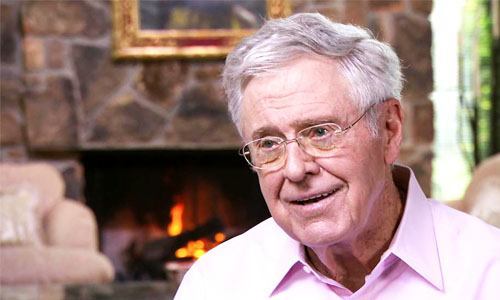
Charles Koch Misled CBS: The Kochs’ Political Spending Is Not Publicly Disclosed

Charles Koch misled CBS when he suggested that the Kochs’ political spending is publicly disclosed.
On Oct. 11, the elder Koch brother gave a rare interview to CBS Sunday Morning. Reporter Anthony Mason asked, “Do you think it’s good for the political system that so much what’s called ‘dark money’ is flowing into the process now?”
"What I give isn't dark… what I give politically, that's all reported." — Charles Koch on political contributions pic.twitter.com/r9tNwpWK7P
— CBS Mornings (@CBSMornings) October 12, 2015
Koch replied: “First of all, what I give isn’t ‘dark.’ What I give politically, that’s all reported. It’s either to PACs or to candidates. And what I give to my foundations is all public information.”
This is untrue, according to documents obtained by the Center for Media and Democracy last year.
In addition to the hundreds of millions flowing into politics by way of the Kochs’ network of foundations and funding vehicles like Freedom Partners, funds from the corporate treasury of Koch Industries—the second-largest privately held company in the world—flow into politics and Charles’ brother David is known to have written millions of dollars in personal checks to political groups each year.
"What we are after is to fight against special interests." — Charles Koch on political contributions pic.twitter.com/Ljz0orBb0R
— CBS Mornings (@CBSMornings) October 12, 2015
None of this spending is publicly disclosed.
Koch and Koch Industries Donations Offer Snapshot Into Koch Network
Donations made by the Koch family foundations—the Charles G. Koch Foundation, the David Koch Foundation and the now-closed Claude R. Lambe Foundation—must be publicly reported.
The Koch political network has also established a complicated array of funding vehicles, like Freedom Partners and the Center to Protect Patient Rights (now known as “American Encore“), to funnel hundreds of millions to politically-active nonprofits like Americans for Prosperity (AFP) and American Future Fund. Although the original donors for these funding vehicles are kept secret, by law, these groups must disclose the grants they make to other groups, providing some insight into the Koch network’s political spending.
In contrast, there is no public reporting requirement for donations directly from the personal bank accounts of David and Charles Koch, who together are worth an estimated $83 billion, unless donating directly to a candidate or PAC.
And, there is no public reporting of contributions from Koch Industries itself. Koch Industries is a closely-held company, so its majority owners, David and Charles Koch, do not have to publicly disclose how they use profits from the company’s $115 billion in annual revenue to fund their personal political agenda.
Yet documents obtained by Center for Media and Democracy show that that the Kochs themselves and Koch Industries are pouring millions into politics, with zero public disclosure.
These documents do not provide a comprehensive list of private Koch donations, but instead offer a glimpse into the nearly incomprehensible breadth of the Koch political universe. That universe goes beyond the $400 million the Kochs and their operatives raised and spent through the Freedom Partners/Center to Protect Patient Rights network in 2013.
It is likely that both David Koch himself and Koch Industries have given more to the groups discussed below and to others in additional years, but those records have not been made available.
Known donations from Koch Industries include:
- $902,500 to Americans for Prosperity in 2000 and $952,500 in 2001;
- $504,000 to the American Legislative Exchange Council (ALEC) in 1998;
- $25,000 to the American Conservative Union in 2010 from Koch’s lobbying arm, Koch Companies Public Sector;
- $100,000 to the Pioneer Institute in 2005 and $75,000 in 2003 from “Koch Business Holdings LLC.”
In press releases, Koch Industries has tried to draw a line between its corporate interests and its owners’ political interests. It states on the KochFacts website, for example, that “AFP and AFP Foundation operate independently of Koch Industries.” Yet, it is now known that Koch Industries itself was pouring as much as $1 million each year into AFP during the early 2000s, the only years that such records are available, in addition to contributions from the Koch family foundations and David Koch himself. It is not known how much Koch Industries or the Kochs may have provided to AFP in more recent years, as the group has played an increasing role in elections and its budget has grown exponentially.
In some cases, donations from Koch Industries exceeded donations from the Koch family foundations. For example, in 2010, the Texas Public Policy Foundation—the State Policy Network affiliate in Texas that once counted Ted Cruz as a fellow—received $159,834 from Koch Industries, nearly double the $69,788.61 that the Kochs’ Claude R. Lambe Foundation disclosed as giving to the group.
Known donations from David Koch himself include:
- $850,000 to Americans for Prosperity in 2003 (making him the top donor that year), $1 million to AFP in 2001 and $1 million to AFP’s predecessor Citizens for a Sound Economy in 2000.
- $100,000 to the Competitive Enterprise Institute in 2009.
- $125,000 to the Massachusetts-based State Policy Network member think tank Pioneer Institute for Public Policy Research in 2007 (making Koch the largest single donor that year) and $100,000 to the Pioneer Institute in 2005.
- $25,000 to the George Washington Institute for Religious Freedom in 2009.
- $150,000 to the Bill of Rights Institute in 2011.
- $400,000 to the Institute for Humane Studies in 2007.
All of these contributions are in addition to millions of dollars of donations, cumulatively, from the Koch family foundations.
YOU MIGHT ALSO LIKE
CBS to Charles Koch: Is Dark Money Good for the Political System?
House Passes Bill Lifting Oil Export Ban, Despite Veto Threat
Ted Cruz Lies Again About the Science of Climate Change
California Governor Signs Ambitious Climate Change Bill Forcing Public Pensions to Divest From Coal

 233k
233k  41k
41k  Subscribe
Subscribe 